|
Sale Fell, Rivings, Wythop Old Church, Ling Fell,
Wythop Mill, Cumbria. |
|
|
Lat/Long: 54.660440,
-03.254229 OS Grid ref: NY 19190 30206 There were still warnings of frozen snow and ice on the high fells so I thought I’d go for a low level walk. In Mar 2012 I investigated the fells around Sale and Ling fells. I planned a modified walk based on the route I took then. I had an easy drive to the lane between the Pheasant Inn and Wythop Mill and parked on a wide verge east of St Margaret’s Church. Other cars were already there, mostly dog walkers. I followed a diagonal path up the north side of Sale Fell. Part way up was a flat area with a seat and commanding views. |
|
| Further up I turned left to continue my climb of the fell. The main path seemed to head for a quarry but a minor path a bit lower was the correct route. It soon connected with a larger path also coming up from the St Margaret’s Church area. It had been a cold start at just above freezing but when I met the sunshine at the gate on the east side of Sale Fell it warmed up considerably. I continued to the next gate and a wide dry path to the Sale Fell summit area. It doesn’t have a particular summit, just a few humps and a rocky outcrop to the west. |
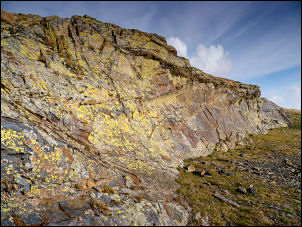 Rock face below Sale Fell summit |
 View from Sale Fell towards Skiddaw |
|
| I returned back the way I’d come and through the gate and south east to the summit called Rivings where there was a large cairn marking its summit. The path continued down through gorse to join the old track along the south side of Sale Fell. It soon entered Chapel Wood. A note in St Margaret's Church on the other side of the fell says "Chapel Wood is said to be the oldest surviving oak planting in the British Isles" though I don't know how anyone could know or prove that. The track is a delightful walk through the woods and before long I reached the remains of the old Wythop Chapel. |
 Track through Chapel Wood |
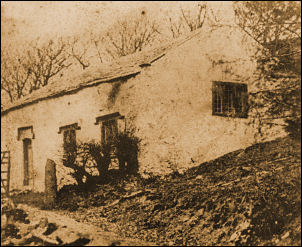 The Old Wythop Church in 1865 |
 The same view today |
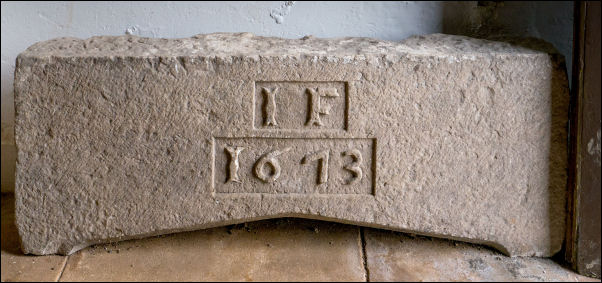 The lintel from the old Chapel is now in St Margaret's Church |
|
|
It is unfortunate that a
large gate just before the ruins spoiled the view of it. There is an old
1865 photograph of the chapel in St Margaret’s showing the chapel just
before it was demolished. The same view is now obscured by the gate. The
ruins are between 1 and 2 metres high and a marker stone inside reads
‘SITE OF WYTHOP OLD CHURCH’ It looks more like a gravestone and dates from
1904. On Sunday, 24th July, 1904 the Rev. P.N. Kennedy dedicated a Memorial Stone in the ruins of the Old Church at Kelsick. |
 All that's left of Wythop Old Church |
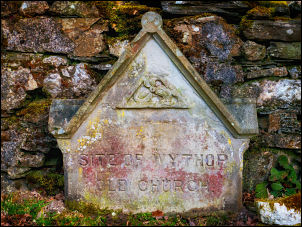 ‘SITE OF WYTHOP OLD CHURCH’ from 1904 |
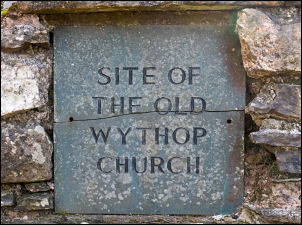 Memorial in the wall |
|
There is an interesting sheet of information about the old church in the
entrance porch to St Margaret’s Church and also the dated door lintel from
the old church. The text is below: |
|
|
KELSICK CHURCH The remains of the old chapel, which is reputed to be Celtic, are still to be seen alongside the track which passes through Chapel Wood below Sale Fell. Chapel Wood is said to be the oldest surviving oak planting in the British Isles. The chapel was rebuilt between 1553 and 1558 and was probably used as a Chapel of Ease for coffins. In 1673 a more substantial building was built, which served the congregation until 1865-66. The Communion Table was a narrow board, supported by a moveable bracket inside the Reading Desk, and the vessels used for the celebration of the Lord's Supper were a cheese plate and a pewter pot. There was no Vestry, and as there was no Font or Burial Ground, all Baptisms, Marriages and Burials took place in Lorton. There was no school-room, the children having to meet in a cottage at some distance from the chapel. The bell, which was reputed to be a **'kail-pot'. hung in a tree close by, and was to be heard tinkling throughout the week, depending on the movements of the tree. The tree was felled to give the chapel more light, and the bell went with it. Until 1842 the floor was not even paved, and was said to yield a goodly crop of nettles! The wood for the new floor was given by Lady Vane and hewn by John Coulson in a day and a half, and he also made a "specification for pewing chapel" at 9s. 6d., but the work cost £15. 17s. 3d. Access to the chapel, which meant a steep climb of upwards of a mile in many cases, made attendance difficult, especially in bad weather and for the "aged poor". It became obvious that there was a need for a larger, more suitable building. The chapel was partially pulled down in 1865, leaving a roofless outline of the original building. The lintel from the door was taken to St. Margaret's, where it is now on view in the Porch. On Sunday, 24th July, 1904 the Rev. P.N. Kennedy dedicated a Memorial Stone in the ruins of the Old Church at Kelsick. |
|
| Continuing west I descended down to a footbridge over Wythop Beck and on towards Old Scales farm. Just before reaching the road I saw a barn and small building nearby with a chimney stack in the corner. Inside was a fire grate and metal basin above. Across the road I saw a farm worker in the farmyard and asked him if he knew what it was for. He didn’t. |
 The boiling pan |
 Outbuilding and chimneystack |
|
| I turned left and followed the lane west below Low Burthwaite Wood until I came to a gate and paths heading up to Ling Fell. I set of up taking the left track that climbs steadily up the east side of the fell. I continued round to ‘Bladder Keld Spring’ spring which is shown on the map. I miss-read its location and continued through the gate to investigate further along. It turned out to be on the east side of the gate. I followed the fence steeply up the fell towards Ling Fell summit. |
 Ling Fell summit trig post |
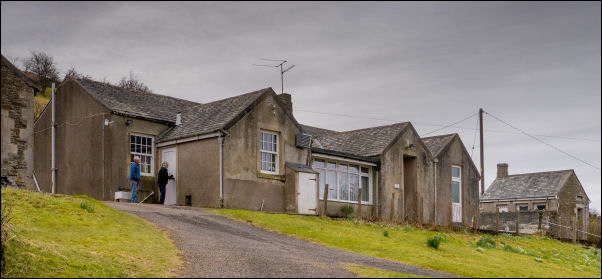 The old Wythop School seems to be a community centre |
|
| There is no path shown on the map but enough people have walked this way to make a faint route. The steep gradient soon eased and I wandered across to the summit trig post on Ling Fell at 373m. Distant view were cloudy but it was a very nice location and I had the whole place to myself. I started my descent to the north, passing some stone built grouse butts on the way. I joined a green track called ‘Corpse Road’ on the map and followed it down to the gate near Eskin where I had started my climb of Ling Fell. At the road I turned left and followed the road back to the old school which now seems to be a community building. | |
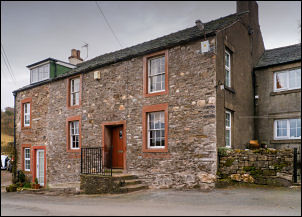 The Globe building Wythop Mill today No longer a pub |
 The Globe building 6 years ago |
| I descended down to Wythop Mill then up to the long straight road back towards the start of my walk. On the way I passed the isolated building of Wythop Sunday School. It was built by public subscription in 1887 (Queen Victoria's Jubilee year, 50 years on the throne). The Sunday School was sold in 1977 but planning permission was not granted for conversion into a home. It changed hands again and is still in private ownership but is now locked and no indication what it could be used for. |
 The old mill race in Wythop Mill |
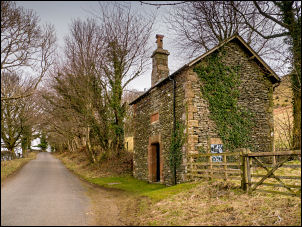 Wythop Sunday School building |
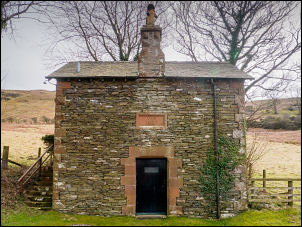 Wythop Sunday School building |
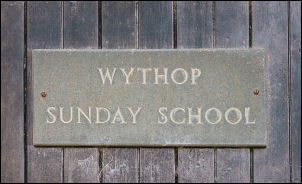 Wythop Sunday School |
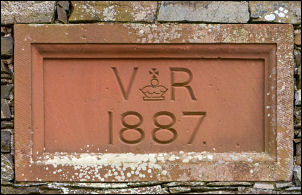 1887 Queen Victoria's Jubilee year |
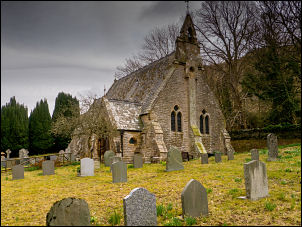 St Margaret's Church |
 St Margaret's Church interior |
| I very soon reached St Margaret’s Church which was built as a replacement to the old Wythop Church whose ruins I visited earlier. The foundation stone was laid in 1865 and the church consecrated by the Bishop of Carlisle on July 31st 1866. The outer walls were constructed from stone from the Tallentire Quarries about 7 miles to the NW. My car was a short way further on. | |
|
|
|